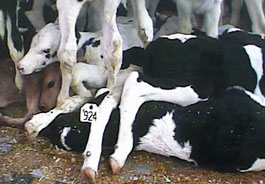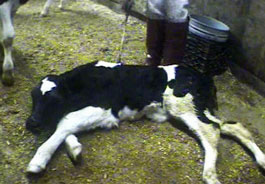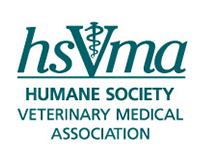Abuse in the Veal Calf IndustryJanuary 13, 2010 By Peggy Larson, DVM, JD The first time I went into a veal barn, I was shocked at the smell of diarrhea and surprised at the 50 gallon barrels filled with empty sulfamethazine bottles. The calves vocalized and constantly licked their stalls. When touched, they would frantically lick my hand—indicating pica, a condition thought to be caused by lack of fiber and mineral deficiency. There was fecal material on their bodies from constant diarrhea or "scours". The stalls could not be kept clean because of the constant defecation, and the stench was overwhelming. Some were ill and required fluids and medication. An unnatural practice The mistreatment of veal calves is all too common in this industry. The HSUS Science has shown that milk fed veal calves are not optimally healthy because of their inadequate diet and restricted movement. In one study, calves raised in stalls showed impaired locomotor ability, sometimes stumbling when led to an open field.1 Research has shown that feeding grain reduces the incidence of calf scours2 and feeding fibrous materials reduces the need to treat calves for low hemoglobin, or respiratory and gastrointestinal diseases.3 Because of their dietary deficiencies, an assortment of antibiotics have been used to keep milk fed veal calves alive.<4,5,6 The use of medical treatments may decline after the first 28 days to 5%, depending on the level of animal husbandry practiced in the facility7, but even so, some antibiotic residues are still found in the meat of bob veal at slaughter.8 With two of the leading causes of calf death being respiratory and digestive infections, most calves are treated with antimicrobials—as a preventative measure—when they arrive at the farm, and many receive additional therapeutic treatments as they grow older.9 Over the years, synthetic testosterone, clenbuterol, and myriad antibiotics have been administered to these calves.10,11,12 Some of these drugs are now illegal because they could not be removed entirely from the calf prior to slaughter.13 However, illegal drugs are still administered to veal calves. As recently as September 2009, a veal calf producer was fined for giving his calves formaldehyde to control diarrhea and potassium permanganate to bind iron to make the calves even more anemic.14 Based on my experience as a large animal veterinarian, a farmer will try most anything to keep his calves—and his profits—alive. The journey to slaughterWhen veal calves are ready to go to slaughter, they are either trucked directly to the slaughter plant or first delivered to a sales barn, where slaughter plant owners bid on them. Calves who go through a sales barn may be more stressed than those taken directly to slaughter, because they are transported twice and are exposed to unfamiliar surroundings and additional handling in the process of being sold.  Veal calves, often too weak to stand on their own, are prodded with an electric device. The HSUS At the sales barn they are unloaded and herded into a pen without food or water, where they may remain for five or six hours. Often the pen is cold and dirty, leaving them with no clean place to lie down. If they are weak, an electric prod is used to make them move. They are not fed or given water during the trip to the sales barn, during the time they are held for sale, or when they are trucked to the slaughter plant. Bob veal calves and milk fed veal calves are especially at risk for inhumane treatment at both sales barns and slaughter plants, because they are sometimes weak and have difficulty standing. A recent undercover investigation by the Humane Society of the United States15 corroborates my own experiences when stepping in to straighten out problem plants. Currently, an animal has to be able to stand up in order to be slaughtered. If they are down, they will be tagged as "U.S. Condemned" and prohibited from proceeding to slaughter.16 Some handlers will do almost anything to get the calf to stand. This includes shocking them with a 6,000 to 35,000 volt electric prod,17,18 kicking or dragging them, and holding their nose shut so they can't breathe. The attitude of many of the slaughter plant personnel whom I have personally observed is that the calf is going to be killed anyway, so what difference does it make if the animal is treated cruelly. The profit margin in bob veal calves is small, so getting the animal to stand is imperative; hence the cruel treatment.  Peggy Larson, DVM, JD. Cruelty at slaughter plants and sales barns will continue as long as these weak animals can be legally sold and processed. It is a national problem and a national shame. Dr. Larson spent eight years in a large animal practice in North Dakota. Most of her work involved cow calf operations including veal barns. She also provided veterinary oversight to the livestock sales barn during that time. After moving to Vermont, Dr. Larson was assigned to a temporary position as Vermont's State Veterinarian and Meat Inspector for four months to change and enforce meat inspection procedures. She inspected sales barns and slaughter plants along with re-writing the meat and poultry regulations during that time. 1 Dellmeier GR, Friend TH, and Gbur EE. Comparison of four methods of calf confinement: II. Behavior. Journal of Animal Science 1985;60(5):1102-1109. |
